#A Medieval Gold and Garnet Pendant Found in England
Explore tagged Tumblr posts
Photo
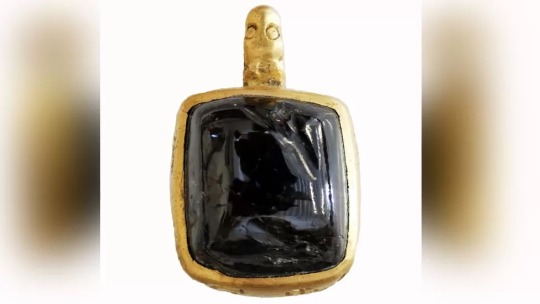
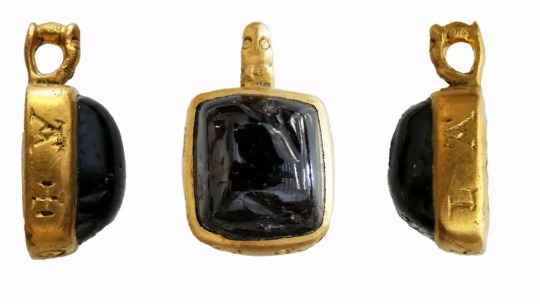

A Medieval Gold and Garnet Pendant Found in England
A medieval gold and garnet pendant inscribed with a "magical" Hebrew phrase has been declared treasure.
The jewel was discovered by a metal detectorist at Great Tey near Colchester, Essex, in August 2021.
The pendant is inscribed with an abbreviation of a Hebrew phrase meaning "Thou are mighty forever O Lord".
County finds liaison officer, Lori Rogerson, said its "noble" wearer was "invoking the protection of God in the most magically-powerful language".
The late 12th or early 13th Century object is inscribed with the letters AGLA, which is an abbreviation of the phrase Atha Gebri Leilan Adonai.
This inscription has been found on a range of medieval jewels, said Surrey liaison officer Simon Maslin in his report for the Essex coroner.
Miss Rogerson said: "For medieval Christians, Hebrew was the language of magic, being an ancient language originating from a place with a long tradition of magical practice.
"So the phrase could be seen as doubly powerful by invoking the protection of God in the most magically-powerful language."
This was also a time of rising levels of anti-Semitism - which in England would culminate in Edward I expelling Jewish people from his kingdom in 1290 - so for some Christians, Hebrew was connected to the devil.
Miss Rogerson said "the line between magic and religion were very much blurred" for medieval people.
"This may seem surprising since magic and witchcraft tend to be associated with evil," she said.
"However, this is the legacy of the witchcraft hysteria of the 17th Century, when innocent people were accused of colluding with the devil."
Medieval gemstone pendants were much rarer finds than "very, very common" gemstone set finger rings, said Miss Rogerson.
"And the gemstone added an extra layer of magical protection to the wearer.
"As a creation of God, they were considered to be natural talismans due to their brilliant color and purity."
Colchester Museum hopes to acquire the find.
By Katy Prickett.
#A Medieval Gold and Garnet Pendant Found in England#Colchester Essex#gold#gold jewelry#ancient gold jewelry#ancient artifacts#metal detecting#archeology#archeolgst#history#history news#ancient history#ancient culture#ancient civilizations#middle ages#dark ages#medieval ages
80 notes
·
View notes
Text
I’ve been down a rabbit hole wondering about medieval jewelry (and if I can reproduce it despite having no metalworking skills, to which the answer is mostly no) lately & I figured I would share the fruits of my museum collection searches for other medievalists/hobbyists/reenactors/nerds.
Jewelry of the 13th Century Anglo/Francosphere

TL;DR
Metals: 🟨 gold(tone)
Stones: mostly 🔵 cabochon, rarely 💠 simple cut, some carved 🗿 intaglio or cameo
Stone Colors: warm blues, emerald green, purples, burgundies, reds
Materials: enamel, 💎 gemstones (garnet, Ceylon sapphire, ruby/spinel, emerald) or glass paste imitations, ⚪ semi-precious stones (pearl, lapis, jasper, carnelian, coral, turquoise, porphyry)
Settings: bezel (oval and rectangular); ⚜️ intricate metalwork; more visible and textured metal than modern jewelry; more mixtures of stones and colors than modern tastes
Motifs: ◯ round, ✤ quatrefoil, ✙ cross, ✸ star (even numbers of points), ♣ trefoil, ❦ floral, 🐉 animals, 𝕬 inscription
Formats: brooches, ornamented clothing, rings, pendants, circlets, cuffs (rare)
A detailed look:
Some forms of jewelry that were very popular in the Roman Empire and are again today were just not the thing in the middle European Middle Ages. (Earrings, for example, seem to have barely existed. This is partially at least because ears were covered--by coifs and caps, hair, and (for women) braids or the chin strap and fillet/wimple/gorget.) In fact, a lot of the places we would put jewelry against our skin today were covered.
This left some other options:
Jewelry on Clothing
Medallions
Okay, these aren’t jewelry, strictly speaking, but they’re metalwork ornaments associated with a person.
Enamel Mitre Medallions

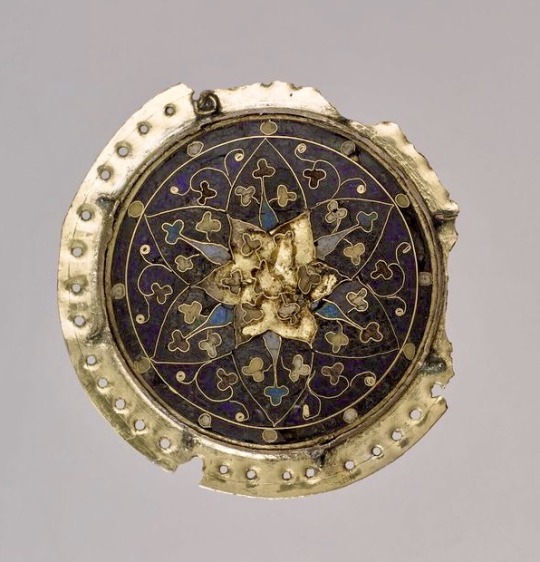
OA 3437 and OA 3438 Before 1291, Ile de France Louvre, Paris photos (c) Musée du Louvre / Stéphane Maréchalle 2015
Cloisonné and plique enamel over gold and copper, with decorative motifs of trefoils, quatrefoil, and stars in a palette of dark blue and green with accents that may once have been ruby red.
Appliqué Medallion
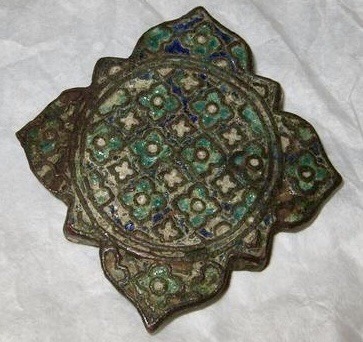
# MRR 256 13th c., Limoge Louvre, Paris photo (c) Musée du Louvre 2014
Gilded copper (though most gold is worn off) with quatrefoil champlevé enamel in emerald green, lapis blue, and white or off-white.
Brooches
Perhaps the most prevalent medieval jewelry item in the Anglo & French regions. These were worn at the shoulder for men and breast for women, often anchoring a cloak, or to close the collar. As the ornate fermail and double-ring brooch suggest, these ran the gamut from practical to incredibly decorative and ornate.
Garnet & Silver Gilt Animal Ring Brooch; Green and Blue Glass and Gilt Ring Brooch

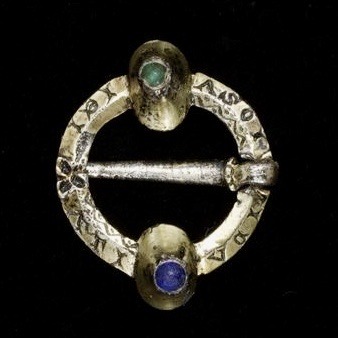
Left, # 2003,0703.1 13th century; found in Suffolk, England British Museum, London photo (c) The Trustees of the British Museum
Right, # M.28-1929 13th c., England V&A, London photo © Victoria and Albert Museum, London
Cabochon garnets or carbuncles in the gilded silver brooch (L), perhaps once paired with smaller stones in the eyes of metalwork animals that bite the pin bracket. The right brooch, also silver gilt, sports two glass paste emerald and sapphire "gems" in cabochon. It was probably a lover's token; it reads (in Lombardic-lettered French) IOSV ICI ATI VCI or "jo su[i] ici a t[o]i v[o]ici" which I might translate as "I am here with/belonging to you, look!"
Ruby & Sapphire Ring Brooch; Sapphire, Garnet, and Pearl Fermail


Left, # 6808-1860 1275-1300, England V&A, London photo © Victoria and Albert Museum, London
Right, # OA6287 1250-1300, France Louvre, Paris photo (c) Musée du Louvre
Blogs often claim that stones were only polished en cabochon until the 16th century, and that medieval jewelers couldn't cut gemstones. But this 13th-century gold ring brooch (left) pairs table-cut purple rubies with collet-set cabochon sapphires, and may evidence early medieval gem-cutting or reuse of Roman cut stones. The silver gilt fermail, right, includes pearl beads, garnets and sapphires both cut and cabbed, and one glass paste cabochon. Both are intricately textured, with punchwork (L) and floral metalwork, probably cast and then attached (R).
Double Ring Brooch with Sapphire and Glass "Emeralds"
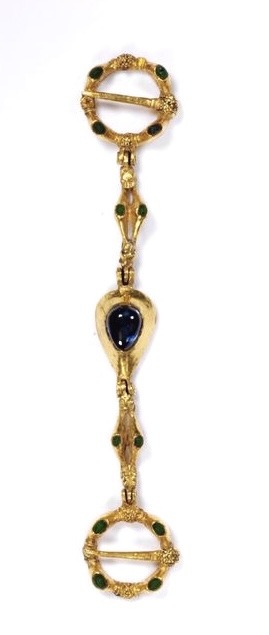
# M.26-1993 13th c., England V&A, London photo © Victoria and Albert Museum, London
This gold double brooch is so small they think it was for a woman or child. Central sapphire cab is flanked by glass paste "emeralds" in bezel settings and metalwork featuring two animal heads.
Jewelry on the Body
Rings
Many are probably familiar with the signet ring, used for pressing into sealing wax, which could be intaglio-carved gemstone or metals. There were also a number of decorative and/or talismanic gemstone rings.
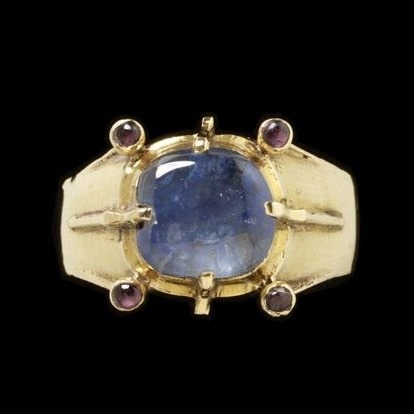

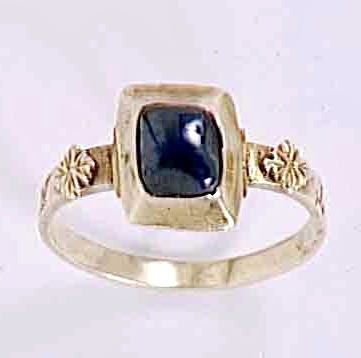
LtR:
#M.7-1929 | #M.180-1975 | #OA 11265 1250-1300, England | 1250-1300, Engl/France | 13th c., Engl/France V&A, London | V&A, London | Louvre, France photos L&C © Victoria and Albert Museum, London | R (c) Musée du Louvre
Sapphire in gold is the name of the game when it comes to rings in the thirteenth century; even the purple stones on the left are purple sapphires. (Sapphires were said to aid chastity, purity, and the effectiveness of prayer.) For larger stones, the bezel often has claws added (L); the central ring is an example of a full claw setting that modern viewers might find surprisingly tall. Naturalistic flourishes are added (C & R); these might be pre-cast then attached to the base (R).
Pendants
We equate pendants with necklaces, but their medieval applications also included wear as badges, from headpieces, and on horse decorations.

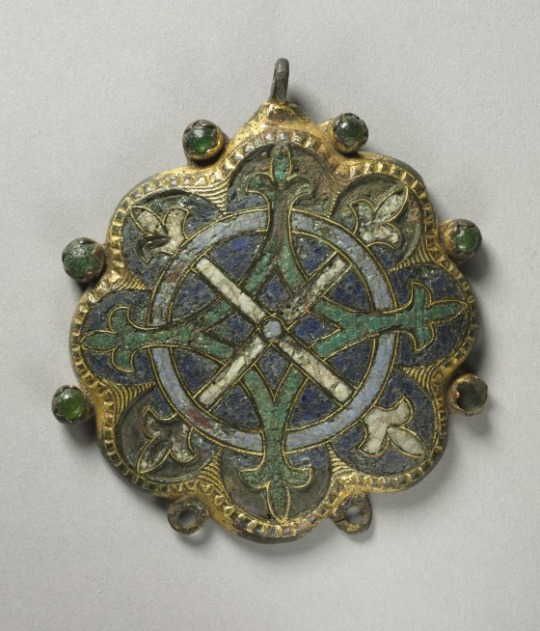
Left, bloodstone jasper cameo in silver setting # MRR 218 1100-1300, France? Louvre, Paris photo (c) Musée du Louvre / Jean Blot 1984
Right, champlevé enamel, gilt copper, and paste "emerald" (harness) pendant # 1976.169 13th c., France Cleveland Museum of Art, Cleveland photo CC0 Open Access
Statue Jewelry
From here, we get into the really ridiculous stuff; the previous categories could be relatively everyday (as much as ornamentation reserved exclusively for the wealthy can be an everyday thing) but the following examples are astonishing displays not necessarily for wear.
"La Couronne" de Vierge et l'Enfant d'ivoire de la Sainte-Chapelle
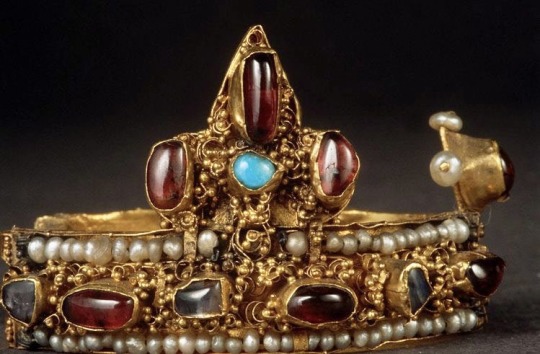
# OA 57 B 1250-1300, France Louvre, Paris photo (c) Musée de Louvre
This was not even a crown for a person, but rather for a painted ivory statue of the Virgin Mary, holding her infant son. (Though circlets, even set with stones, were sometimes worn as part of women's head dress.) It's incredibly ornate gold, set with pearls, garnets and rubies, sapphires, and turquoise (?) en cabochon.
Anneau de Saint-Denis

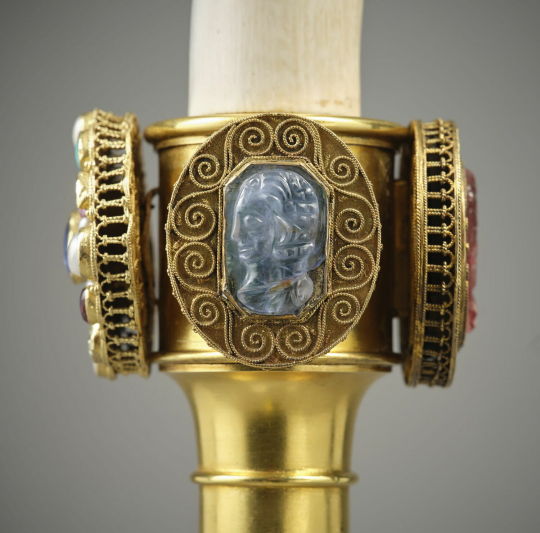


# MS 85 BIS 1200-1215, France Louvre, Paris photos (c) Musée du Louvre / Daniel Arnaudet 1990
This astonishing piece, which is ring-sized but now displayed as a cuff on an ivory hand, is made of gold and displays every possible gemstone appearance characteristic of the period. The front piece has a central sapphire and is surrounded by quartz with red backing (mimicking ruby/garnet), amethysts, pearls, and sapphires, some set on yellow backing (mimicking turquoise?). Most are en cabochon on this face, but two are faceted and two intaglio. Were this not enough, the three other 'faces' of the ring are set with gems as well, two cameos (probably sapphire and garnet?) and one amethyst intaglio set in ornate gold filigree.
#medieval#jewelry making#lapidary#history of fashion#historical jewelry#1200s#reenactment#England#France#enamel jewelry#ring brooch#fermail#intaglio#cameo#gemstones#infodumping#now time to go to the bead store#material history#you would think this is for my research or academically relevant but it's not I just couldn't stop looking at shiny things help#photos not mine#photos for educational purposes and not for commercial reproduction#louvre#v&a museum#british museum#cleveland museum of art
40 notes
·
View notes
Text
Amulet / Charm / Talisman
An amulet is any object (usually small in size) intended to bring good luck and/or protection to its owner, or any object believed to hold magical properties that can protect against bad luck, illness and evil. It may be used for specific purposes, or just for general good luck. Potential amulets include gems, crystals, simple stones, statues, coins, drawings, diagrams, pendants, rings, plants, animals, even words. They are often worn as a necklace or pendant, although they can be worn anywhere (the closer to the body they are worn, the more powerful their magic is believed to be).
A talisman is also an object that possesses magical or supernatural power, and there is much debate on the exact difference between an amulet and a talisman. Some argue that the power of a talisman is of a greater magnitude, or that a talisman is able to be magically charged and to transmit its power to its owner or wielder, or that a talisman is used for specific, rather than general, purposes. They are usually more complicated affairs than amulets, often involving carved or engraved figures, or bearing magical symbols or inscriptions in gold, etc. Generally, talismans are not worn, but may be carried in a pocket or purse, or kept near the object they are intended to benefit (e.g. tacked over a child's bed). When linked with an appropriate spell, they greatly increase its strength, although they can also be used alone, for their intrinsic magic is considered powerful.
Charms are generally items of folk magic and superstitions, such as a lucky horseshoe, a four-leaf clover, a rabbit’s foot, a baby’s caul or a bracelet of personal charms signifying important things in the wearer's life. A charm can also be used to refer to a simple verbal spell.
Charms, amulets and talismans have been used in folklore in all parts of the world and throughout history, from the hamsa (or “Hand of Fatima”) and nazar (or “blue eye stone”) used to protect against the evil eye in Arab countries, to the “gris-gris” used in Vodou as charms for good luck or protection, to the “cold-stones” (small rounded beach pebbles, painted with dots, wavy lines and geometric shapes) that were held to cure sickness in animals and humans by the Pictish tribes of northern Scotland. “Touch pieces” (coins and medals, especially those with holes in them or those with particular designs) were believed to cure disease, bring good luck and influence people’s behavior since Roman times; pendants in the magically potent shape of a pyramid pointing to the gods (often colored black and white to express the opposition of good and evil) were worn in Asia Minor; an exaggerated apotropaic eye was painted on Greek drinking vessels as early as the 6th Century B.C. to ward off evil spirits while drinking; an amulet formed from the natural knot-hole of a tree branch was used in magic-making in medieval rural England. Possibly the most powerful talisman in modern witchcraft and Wicca is the pentacle.
In many societies, religious objects serve (or have served) as amulets, such as the figure of a certain god or some symbol representing the deity (e.g. the cross for Christians, the Buddha pendant, the "eye of Horus", the “eye of Ra” or the "ankh" symbol for the ancient Egyptians). In demonology and Satanism, an inverted cross or a pentagram in downward position are amulets used when communicating with demons.
Precious and semi-precious stones and crystals are commonly used in amulets and talismans, each stone having its specific significance and power (e.g. amber wards off evil spirits and protects against rheumatism; aquamarine brings love, hope to the oppressed and protects travelers; diamond repels wild beasts and evil men, and ensures fidelity in a lover; emerald strengthens the memory and prevents possession by evil spirits; garnet brings good health and protects against nightmares; lapis lazuli, like all blue stones, protects against black magic and wards off melancholy and insomnia; onyx protects a marriage from intruders; pearl improves the skin, cures fevers and brings tranquility; sapphire brings peace and happiness and protects the eyes; topaz helps to locate buried treasure; turquoise brings peace to married life; etc.).
Different symbols and shapes are also considered to have different magical properties. For example, the shape of a bee brings success in business; a black cat is one of the best all-around good luck charms known to witchcraft (contrary to popular superstition); anything egg-shaped brings good luck and is a powerful fertility charm; a fish brings a large family, especially if cast in gold or mother of pearl; a stone arrowhead is a powerful force against evil spirits; the shape of a hand is another powerful charm against evil spirits; anything in the shape of a sacred oak tree, or a piece of oak itself, is lucky; the shape of a pig is a potent bearer of fertility; the form of a serpent brings long life and wisdom; etc.
Many amulets and talismans are made from letters or numbers that may appear meaningless, but are believed give off excellent vibrations, and they can be powerful magical aids.
Thor’s Hammer - Mjolnir
Mjolnir means lightning, and Thor’s hammer indicates the god’s power over thunder and lightning. Thor, ancient god of war is one of the most prominent figures in Norse mythology. Thor who was the storm-weather god of sky and thunder and also a fertility god, was the son of Odin and Fyorgyn, the earth goddess.
Thor’s hammer, Mjolnir is depicted in Norse mythology as one of the most fearsome weapons, capable of leveling mountains. One Norse story tells what happened when he lost his precious hammer.
Mjolnir was a magical weapon that always came back to Thor when he threw it. Wearing Thor’s hammer as an amulet of protection was quite common as this was probably the most popular of all the pagan Viking symbols. Even during Christian times, from A.D. 1000 on, Vikings wore Thor’s Mjolnir as well as a cross on a chain or thong around their necks.
Yggdrasil - Norse Tree Of Life
In Norse mythology, the Yggdrasil is a giant mythological tree that holds together the Nine Worlds or realms of existence.
At the very top of Yggdrasil, an eagle lived and at the bottom of the tree lived a dragon named Nidhug. Both hated each other and were bitter enemies. The Nine Worlds are guarded by the serpent Jormungandr. Yggdrasil is one of many variations of the Cosmic Axis or Universal World Tree known to all human cultures and home to many fascinating creatures.
The image of Yggdrasil appears on the famous Överhogdal Tapestry, which dates to the year 1066 and depicts the events of Ragnarök, the doom of the Gods and apocalyptic record of the coming comet. Read more
Valknut – Viking Symbol For Death In A Battle
The Valknut, also known as Hrungnir’s heart, heart of the slain, Heart of Vala, and borromean triangles is a mysterious Norse symbol. its true meaning is still debated, but it is often associated with a warrior’s death in a battle.
The symbol has been found on old Norse stone carvings and funerary steles. It is sometimes called “Hrungnir’s heart,” after the legendary giant of the Eddas. It's also possible to find a depiction of the Valknut on stone carvings as a funerary motif, where it probably signified the afterlife. In art, the Valknut is a representation of God Odin, and it demonstrates gods’ power over death. A Valknut is also believed to offer protection against spirits which is the reason why it is often carried as a talisman.
A Valknut is made of three parts, and the number three is a very common magic symbol in many cultures. In this case, the symbolism in Norse mythology showing three multiplied by three might designate the nine worlds, which are united by the Yggdrasil tree. In modern times Valknut, like Triquetra and Horn Triskelion, is often interpreted as a symbol pointing to heathen convictions.
Helm of Awe
The Helm of Awe is one of the most powerful protective symbols used not only for the purpose of protection from disease, but even to encourage all people who might suffer from depression or anxiety.
In Norse myths it is said that the Helm of Awe symbol was worn between the eyes to cause fear in your enemies, and to protect against the abuse of power. The Norse word for this very important symbol (Ægishjálmr or Aegishjalmur) is translated in English "helm of awe" or "helm of terror." The meaning of the name awe is to strike with fear and reverence; to influence by fear, terror or respect; as, his majesty awed them into silence.
Huginn And Muninn – The Twin Ravens In Norse Mythology
Among the Aesir gods in Norse mythology, the supreme god Odin, is frequently depicted sitting on his high seat, Hlidskjalf, in Asgard, the home of the gods.
Odin always has his two raven companions, Hugin (Huginn) and Munin (Munnin) on his shoulders.
Hugin is believed to represent ‘memory’, while Munin personifies ‘thought’. Every day, Odin sends them out and they fly across the worlds to seek for important news and events. Odin surveys the worlds from Hlidskjalf and must know reports of what is going on in all Nine Worlds. In the evening, Hugin and Munin return to Odin’s shoulders and during dinner in Valhalla, they whisper all they have heard in his ears.
Web Of Wyrd (Skuld’s Net) – Viking Matrix Of Fate
In Norse mythology the concept of fate is reflected by the Web of Wyrd that is created by the Norns who were known as ‘Shapers of Destiny. The Norns were goddesses who ruled the fates of people, determined the destinies and lifespans of individuals.
With its nine stave, the Web of Wyrd is a matrix of fate that represents past, present and future events in a person’s life. Norse people believed that everything we do in life affects future events and thus, all timelines, the past, present and future are connected with each other.
Troll Cross – Norse Symbol Protecing Against Trolls And Elves
The troll cross is an amulet made of a circle of iron crossed at the bottom in a shape of an odal rune. It was worn by Scandinavian people as a protection against trolls and elves.
The Triple Horn Of Odin
The Triple Horn of Odin is yet another symbol of the great Norse God Odin. The symbol consists of three interlocked drinking horns and is commonly worn or displayed as a sign of commitment to the modern Asatru faith. The horns figure in the mythological stories of Odin and are recalled in traditional Norse toasting rituals. In Norse mythology there are some tales describing God’s quest for the Odhroerir, a magical mead brewed from the blood of the wise god Kvasir. There are several account of the tale, but typically, Odin uses his wits and magic to procure the brew over three days’ time; the three horns reflect the three draughts of the magical mead.
Gungnir – The Spear Of Odin
Gungnir was a magical weapon created by the dwarves and given to Odin by Loki. The Gungnir never missed its mark and like Mjölnir, the hammer of Thor, it always returned to Odin.
Vegvisir – Runic Compass
Vegvisir is among the oldest and sacred Norse symbols and it initially originated from Iceland, where ‘Vegur' means - road or path and ‘Vísir’ means – Guide. The symbol was frequently inscribed on seagoing vessels to insure their safe return home.
The device was believed to show the way back home and protect seamen and their ships from storms. The Vegvisir was like a guide helping its bearer to find his way home. Norse people believed that the Vegvisir had special powers and it was treated like talisman for luck, protection and blessings. This powerful symbol could help a person to find the right way in storms or bad weather whatever unfamiliar surroundings he or she may encounter.
It has also long played an important role among people who believe in magic powers, such as Norse Shamans. As a spiritual compass, this magical device guides your heart and steps to make the right choices in life. If you have lost yourself and your faith, this sacred symbol helps you find confidence again.
4 notes
·
View notes
Text
Shrewsbury + 1.5 millionth archaeological object unearthed by the public – But what about Shropshire?
The British Museumâs Portable Antiquities Scheme has reached an incredible milestone after recording the 1.5 millionth archaeological find that was discovered by the public, and it was found in Shropshire.
Since its launch in 1997, the Portable Antiquities Scheme (PAS) has dramatically changed archaeology by encouraging finders to bring objects they find forward for recording. The item that helped cross this historic milestone was a medieval lead papal bulla (a seal for authorising papal documents, such as edicts and indulgencies) of Pope Innocent IV (r.1243-54), that was found in Shropshire.
The Bridgnorth Bulla was the 1.5 millionth archaeological discovery recorded by the PAS.
Peter Reavill, Finds Liaison Officer with PAS, said:
âThe findspot is from the Bridgnorth area, Shropshire and the find has been reported virtually / digitally due to COVID-19 restrictions. This time has been used by many finders to organise their finds in order to have them recorded by PAS.
âPapal bullae are lead alloy seals that authenticate documents issued by the Pope in Rome (or Avignon during the Papal Schism 1378-1418). They would be attached to the document by a thick woven cord that passes through their centre. In the 1,500,000 artefacts recorded by PAS there are around 575 bullae dating from the Early Medieval period (Pope Leo III AD 795-816 and Pascal I AD 8167-824) to the English Reformation and the dissolution of the monasteries under Henry VIII (bulla of Pope Paul III AD 1534-49). It is likely that many of these bullae were attached to documents relating to the buying of indulgencies (time out of purgatory in return for money / land donated to the church). It is the buying and selling of indulgencies that led in part to the Reformation.
âTo date the PAS have recorded 59 bulla of Innocent IV (1243-54) and this example from Shropshire is the 9th Bulla from all periods discovered within county.â
Emma-Kate Lanyon, Curator at Shropshire Museums, said:
âThe data the Portable Antiquities Scheme generates about what is being found both locally and nationally, has helped us to better grasp the context of objects in our museums. We now have a far better understanding of whether certain types of artefact are common or rare and their distribution. This sort of data really helps us to comprehend how certain objects were used, exchanged and deposited.Â
âWorking with our local Finds Liaison Officer, the scheme has also allowed us to develop our collections by acquiring key objects and fill in gaps. As a result, our museums are better at telling Shropshireâs story. Some finders and landowners generously donate their finds. Others are happy to work with us to loan finds or allow us to purchase them with financial support from our Museum Friends groups and other charities. This has greatly enhanced both our museum displays across the county but also provides a vital resource behind the scenes for future research and study.â
Here are six of the most important archaeological objects discovered in Shropshire and on display with Shropshire Museums.
Westbury Axe-Hammer
Not all finds of significance are made from precious metal. This stone axe-hammer was brought in for identification after it was found in a water channel at Westbury, Shropshire in 2013.
The Westbury Axe Hammer
Axe-hammers of this type are the most common type discovered in Shropshire and the Marches area. This is due to the stone being sourced from a site at Corndon Hill, Shropshire.
During the Late Neolithic to Early Bronze Age date (2500-1800 BC) a range of perforated stone tools were produced. These include axe-hammers and mace heads. The differences between each of these types of artefact and how they were used is still uncertain. Therefore, additional finds and data is key for archaeological research and study to understand them better.
This example was donated to Shropshire Museums and is currently available for research and study by appointment at Shropshire Museums Collections Centre.
Shropshire Iron Age Spoons
In 2005 an unusual pair of bronze spoons were found by a metal detectorist searching in the Oswestry area. These spoons belong to a well-known, if rare, type of Iron Age object. Until this discovery there were only 23 examples known.  Apart from one find in France, these spoons have only been discovered in Britain and Ireland, usually as pairs.
Iron Age spoons found in Shropshire
Their function is unknown, but they clearly belong as a pair with one spoon bowl divided by a cross and the other plain but with a single perforated hole near one side approximately half way down the spoon.
The rarity of such a find make the Shropshire Iron Age Spoons a find of national importance. They were acquired with assistance of Friends of Shrewsbury Museum and Art Gallery, The V&A Purchase Grant Fund and Art Fund and can be seen on display at Shrewsbury Museum and Art Gallery.
Easton Constantine Amulet Capsule
In 2001 a metal detectorist discovered this gold Roman amulet or talisman capsule. It would have contained either a rectangular plaque (lamella) of thin gold sheet, lightly incised with a text and magical symbols or a mixture of substances such as sulphur, beeswax or haematite. Such amulets were worn as a protection against evil or disease.
The Easton Constantine Amulet
Very few inscribed gold amulets are known from Britain. The only other complete example to date (in Britain) is from the 4th century AD Thetford Hoard. This example was acquired with assistance from Friends of Shrewsbury Museum and Art Gallery and can be seen at Shrewsbury Museum and Art Gallery.
Since the Easton Constantine Amulet Capsule was discover second example has been found in the County which Shropshire Museums hopes to acquire. Research suggests that these items may be associated with a specific religious group and are evidence for the presence of a small Eastern immigrant community in the area in Roman times.
West Shropshire Pendant
The West Shropshire pendant was discovered by metal detectorists in 2004. This remarkable Anglo-Saxon pendant is composed of a well-polished garnet surrounded by a border of small rectangular notched cloisonné garnets set over waffle-pattern gold foil.
Saxon Pendant
The pendant would probably have been part of a high-status necklace of several such pieces strung together. Complete necklaces are very rare and are usually found in high status graves of the period.
This type of high-status Anglo-Saxon metalwork is almost without precedent in Shropshire. In fact, until the Portable Antiquities Scheme was introduced, early medieval finds in general were rare in the county, making this find all the more significant. The workmanship of the pedant is very fine and suggests that the piece was made in Kent. It is comparable to the only similar find from the county, the Dinham Pommel (on display at Ludlow Museum). The pedant was acquired with assistance from the Friends of Ludlow Museum, the Ludlow Museum Development Trust, The V&A Museum Purchase Fund, The Headley Trust and the Arts Fund.
Myddle Medieval Doublas Hoard
The Myddle Medieval hoard was found by metal detectorist in September 2007. All the coins found are Spanish gold and were deposited together at some time in the late 1360s-1370s. The coins were minted during the reign of Peter I, King of Castile (known as ‘Pedro the Cruel’) and were struck at Castileâs main mint in Seville.
Coins from the Doublas hoard
The best explanation for the presence of these coins in England is that the sons of King Edward III were heavily involved in Castilian politics. In 1367 Edward’s eldest son, the Black Prince, led an army to restore Pedro I to power. Pedro was murdered two years later, but in 1371 Edward’s fourth son John of Gaunt married Pedro’s daughter Constance, and subsequently sought to claim Castile in her name. The coins found at Myddle could well have been the possession of a follower of the Black Prince who returned from the successful 1367 campaign, possibly a member of the Le Strange family of Myddle Castle.
Gold coins of the 14th century are not frequent finds. These are the first examples of gold coinage of this period from the Spanish kingdoms to be found in Britain.  Because of their importance, the hoard was divided between the British Museum and Shropshire Museums. The hoard was acquired with assistance from the Shropshire History & Archaeology Society, the Art Fund and the V&A Purchase Fund and can be seen at Shrewsbury Museum and Art Gallery.
Bitterley Civil War Coin Hoard
The Bitterley Hoard was found in February 2011 by a metal-detectorist and with their help it was archaeologically excavated. The hoard consists of one gold and 137 high denomination silver coins. The coins were inside a high-quality leather purse which was placed within a pottery mug called a tyg. The earliest coin was from the reign of Edward VI and the latest from Charles I, indicating that the hoard was buried after early 1644.
The Bitterley hoard
At this time the English Civil War was raging with castles such as Hopton in South Shropshire being captured by Royalist troops. This was also the year that King Charles I was based in Shrewsbury for a period. With the war raging in the County many prominent families would have hidden their wealth in case of attack. The Bitterley Hoard is the largest surviving hoard this date from Shropshire. It was acquired for display at Ludlow Museum with assistance from the Friends of Ludlow Museum, The Art Fund, The V&A Purchase Fund and The Headley Trust.
The post 1.5 millionth archaeological object unearthed by the public – But what about Shropshire? appeared first on Shropshire Council Newsroom.
https://ift.tt/325S2x0
0 notes
Photo
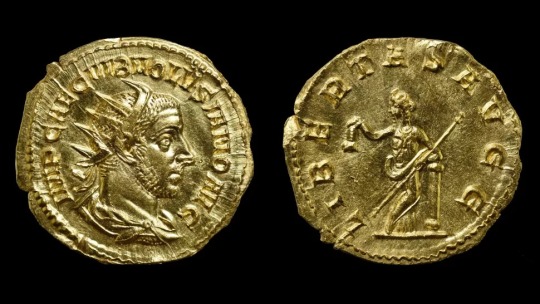
10 Dazzling Gold and Silver Treasures Discovered in 2022
Over the centuries, humans have crafted gold and silver into jewelry, coins and other stunning items. Some of these shiny objects were interred in burials or lost from loose pockets, only to be found hundreds of years to millennia later by archaeologists digging into our past or even unearthed unintentionally by members of the public. Here are 10 extraordinary discoveries that came to light in 2022.
1. 'Cheap Jewelry' is Really Gold Viking Ring
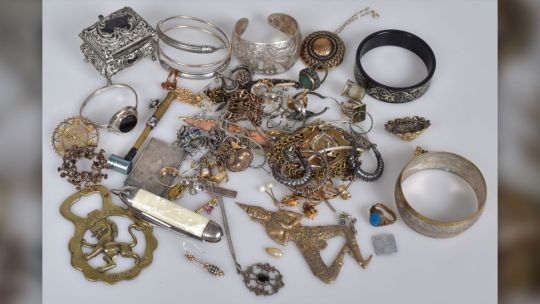
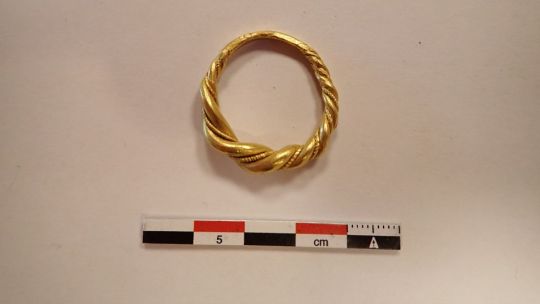
When a woman in Norway bought a bundle of cheap jewelry at an online auction, she was expecting to find some fun costume pieces to wear. Instead, she discovered something else entirely: a large gold Viking ring designed from twisted metal strands. The woman showed the ring to archaeologists, who dated it based on its style. According to the archaeologists, a powerful Viking chief may have owned this ring more than 1,000 years ago.
2. Kitchen Renovation Uncovers Gold Coin Stash
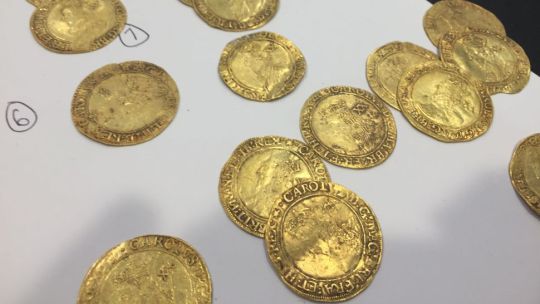
A routine kitchen renovation led to the discovery of a lifetime: a hoard of gold coins hidden beneath the wooden floorboards of an 18th-century house in the U.K. The stash includes more than 260 gold coins dating from 1610 to 1727 and is estimated to be worth around $290,000 (250,000 pounds).
3. Byzantine Gold Coins in Israel
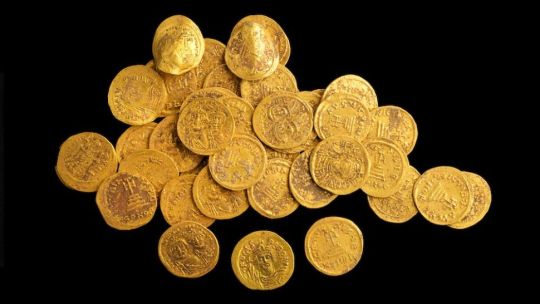
Archaeologists on a nature reserve in northern Israel dug up a trove of 44 gold coins dating to the Byzantine Empire (circa A.D. 330 to 1453). These gorgeous coins date to the reigns of Emperor Phocas (A.D. 602 to 610) and Emperor Heraclius (A.D. 610 to 641). The hoard's owner may have buried the stash before fleeing from Muslim soldiers, who invaded the region in A.D. 635.
4. Gold and Silver Coins near an Egyptian Temple
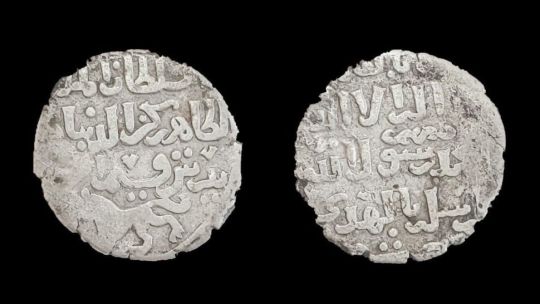
For the last millennium, a cache of gold and silver coins sat buried underground near an Egyptian temple. These coins date to the Islamic era, which lasted from A.D. 610 until the 13th century. The coins are varied, including 286 silver coins of kings and kingdoms from that time, gold coins, a coin from what is now Armenia that was minted during King Leo II's reign in the 13th century, and bronze and brass coins from the Ottoman Empire.
5. 3,000-Year-Old Gold Funeral Mask from China
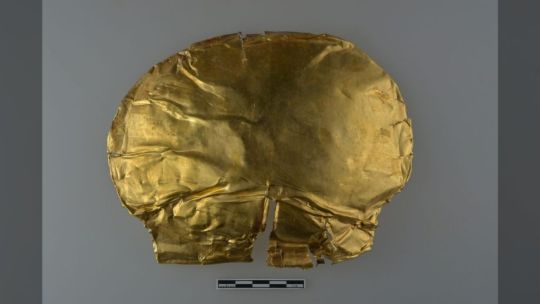
The 3,000-year-old tomb of a noble in what is now central China contained a rich treasure: a gold funeral mask, one of the oldest gold objects ever found in the region. The mask is large enough to cover an adult's face and may have symbolized that the deceased had an "imperishable gold body," researchers said.
6. "Abbess" Buried with Gold-and-Garnet Necklace
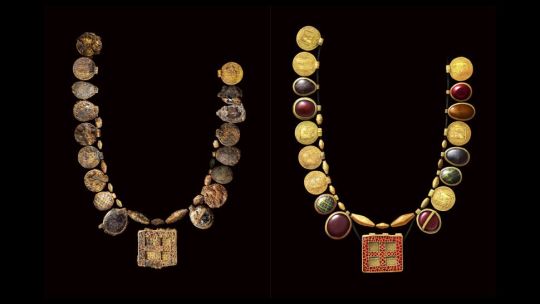
An elite woman buried in seventh-century England was laid to rest with a stunning necklace made of gold, garnets and Roman coin pendants. The burial included two impressive crosses, indicating that this medieval woman may have been an early female Christian leader such as an abbess, or possibly even royalty.
7. Gold Coin Features Assassinated Roman Emperor Volusianus

Excavators unearthed a "very rare" gold coin depicting a murdered Roman emperor in Hungary. The third-century A.D. coin shows the face of Emperor Volusianus, who co-ruled with his father for about two years before his own soldiers killed him and his father. Because Volusianus' reign was so short, coins showing his likeness are rare, especially in Hungary, where Roman gold coins are very uncommon. This coin was very valuable at the time, so losing it must have been a great loss to its owner.
8. Ancient Gold Belt Discovered on Beet Farm
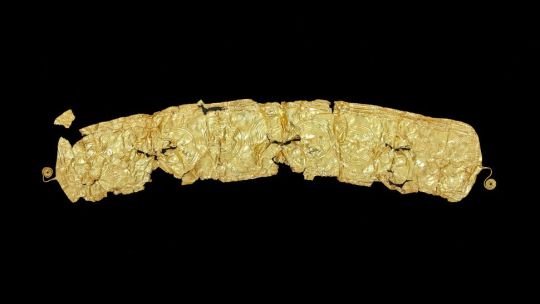
In the Czech Republic, a beet farmer unexpectedly uncovered a crumpled sheet of gold on his land. The farmer alerted local archaeologists, who determined that the gold treasure was likely the front of a leather belt dating to the Bronze Age, nearly 2,500 years ago. Concentric circles decorating the gold sheet might represent cosmological systems, the archaeologists said. It's unclear who owned the belt, but whoever did was clearly elite.
9. Egyptian Ring Depicts 'God of Fun'

A 3,300-year-old burial from ancient Egypt contained a handful of valuable jewelry, including a gold ring with an engraving of the "god of fun." This deity, Bes, was often depicted as a dwarf and was usually portrayed playing music and having a good time. However, Bes was also known for protecting women during childbirth. Archaeologists also found a gold necklace and a ring with an Egyptian hieroglyphic inscription that translates to "Lady of the Earth," but the identity of the woman this inscription refers to is still unknown.
10. Rare Coin Shows Charlemagne Just Before his Death

There are precious few known portraits of Charlamagne made during his lifetime, but now one of them has been found on a rare, 1,200-year-old coin. The coin ended up in the collection of a French farmer, who left his treasured stash to his grandson. When his grandson went through the coins years later and put the Charlemagne item on eBay, German museum curators jumped at the chance to buy it. Charlemagne (ruled A.D. 768 to 814) had the coin, known as a denarius, portray him like a Roman emperor with a laurel on his hat and the dress of a Roman general, even though the Western Roman Empire had collapsed centuries before. Why? Because the Vatican had just crowned him emperor of the Romans on Christmas day in A.D. 800, so the coin was a fitting symbol.
By Laura Geggel.
#10 Dazzling Gold and Silver Treasures Discovered in 2022#treasure#gold#silver#gold coins#silver coins#gold jewelry#ancient artifacts#archeology#archeolgst#history#history news#ancient history#ancient culture#ancient civilizations#roman history#egyptian history#ancient china#bronze age#vikings#long reads
11 notes
·
View notes